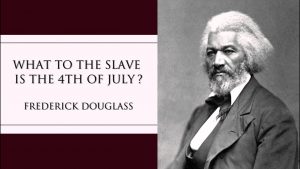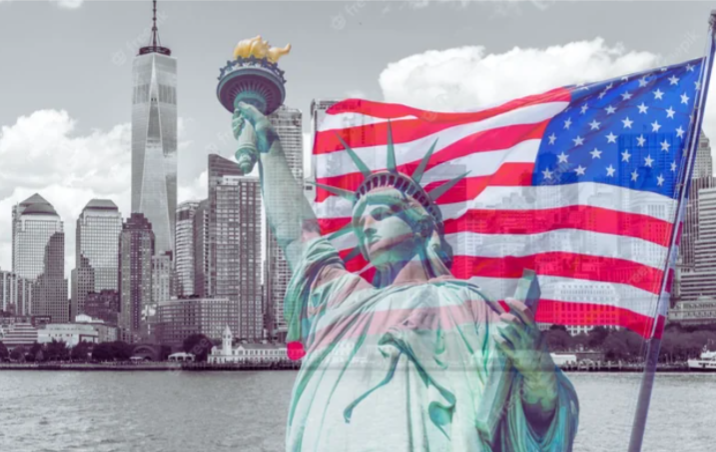(ThyBlackMan.com) On July 5, 1852, the Rochester Ladies’ Anti-Slavery Association expected a mild, polite discussion, and praise of the virtues of July 4th, Independence Day from the leonine, speaker with the shock of maimed hair. His speech would be topped by the standard denunciation of slavery. Instead, they got a speech that would rank as one of the greatest, if not the greatest speech ever uttered by an American orator.
It was brutal, biting, slashing, and wrenching. He tore to shreds every lie, hypocrisy, and bestial justification for slavery. The speaker was unsparing in painting a graphic, gory picture of the whip, lash, gun, rope, and shackles that brutalized and dehumanized the near 6 million Black slaves in America. Most importantly, the speaker ripped apart the grotesque hypocrisy of the Founding Fathers lofty written and spoken words of freedom liberty and equality as false, hypocritical, sanctimonious, and self-serving while those six million were in chains. So hypocritical, that it was not uncommon for slave masters to hold special slave auctions on the 4th of July.
The speaker was Frederick Douglass and he spoke for the ages when he asked, “What to the Slave is the Fourth of July?” Douglass drove his gut wrenching point home by delivering his speech not on July 4th but July 5th.
One hundred and sixty-eight years later, Answering Douglass’s question is still a tough nut to crack not simply because it entails facing an inconvenient truth about America’s past, and the ultimate racial dehumanization, slavery. This was the past that Douglass and the then six million enslaved Blacks lived with daily. Facing that past entails facing the real truth that slavery still corrodes in big and little ways American life. This starts with the truth of why and how slavery became a respected and legitimate part of American life in the first place.
The U.S. government encoded slavery in the Constitution and protected and nourished it for a century. Traders, insurance companies, bankers, shippers, and landowners made billions off of it. Their ill-gotten profits fueled America’s industrial and agricultural might. For decades after slavery’s end, white trade unions excluded Blacks and confined them to the dirtiest, poorest paying jobs.
While it’s true that many whites and non-white immigrants came to America after the Civil War they were not subjected to the decades of relentless racial terror and legal segregation, as were blacks. Through the decades of slavery and Jim Crow segregation, African-Americans were transformed into the poster group for racial deviancy. The image of Blacks as lazy, crime- and violence-prone, irresponsible, and sexual predators stoked white fears and hostility and served as the standard rationale for nearly 4,000 documented lynchings between 1882 and 1968, as well as the countless racial assaults and acts of hate crime violence. The FBI issues an annual reports on hate crimes in America. Blacks are still far and away the greatest target of hate crime perpetrators.
Though some Blacks earn more and live better than ever today, and have gotten boosts from, social and education programs, civil rights legislation, and affirmative action programs, the hideous legacy of slavery is still ever present. The National Urban League in its annual State of Black America reports yearly continually finds that young Blacks are far likelier than whites to be imprisoned, serve longer terms, and are more likely to receive the death penalty even when their crimes are similar.
Blacks continue to have the highest rates of poverty, infant mortality, violence victimization rates, and health care disparities than any other group in America. They are still more likely to live in segregated neighborhoods and be refused business and home loans. Their children are more likely to attend failed public schools than any other group, and more likely to be racially profiled on America’s urban streets. In the era of George Floyd, they are far more likely to die from police bullets than any other group in America.
Then there’s the bill first introduced by former Michigan Congressman John Conyers in 1989 to establish a commission to study the impact of slavery and the feasibility of paying reparations to Blacks has been reintroduced several times since but has gone nowhere in Congress. Reparations is simply too risky, divisive, and distracting for Congress to seriously consider. Former President Obama did speak at times about the need to spend more on education, job and housing programs as the best way to deal with the ills of the Black poor. But that never got much legislative traction.
The brutal truth is that a mainstay of America’s continuing racial divide is its harsh and continuing mistreatment of Blacks. This can be directly traced to the persistent and pernicious legacy of slavery. On that monumental July 4th weekend day one hundred and sixty-eight years ago, Douglass rose before the Anti-slavery group in Rochester, New York to speak. He harshly challenged and mocked America’s flowery words of liberty and freedom with the question, “What to the Slave is the Fourth of July?” Douglass’s question still awaits an answer.
Written By Earl Ofari Hutchinson
One can find more info about Mr. Hutchinson over at the following site; TheHutchinson Report.
Also feel free to connect with him through twitter; http://twitter.com/earlhutchins
He is also an associate editor of New America Media. His forthcoming book is From King to Obama: Witness to a Turbulent History (Middle Passage Press).
















Leave a Reply